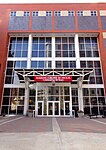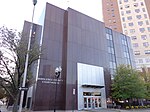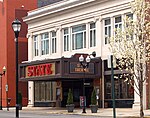Henry Guest House

The Henry Guest House is in New Brunswick, Middlesex County, New Jersey, at Livingston Avenue and Morris Street. It was originally located on New Street (previously known as Carroll Place) between Livingston Avenue and George Street. The Georgian stone farmhouse was built in 1760 by Henry Guest. He was a New Brunswick alderman and an associate of John Adams and author Thomas Paine. It was added to the National Register of Historic Places on May 24, 1976.Henry Guest, who operated a tannery, bought two and a half acres on the corner of Livingston Avenue and Carroll Place (New Street) in 1755. He built a sandstone house five years later and lived there with his family until his death in 1815. Henry Guest said, "If his descendants would only keep a roof on it, the house would stand till Gabriel blew his trumpet." In an 1817 sales advertisement the building was described as "one of the best stone houses in the State of New Jersey."By the 20th century the house was threatened with demolition, and in 1924, it was moved up Livingston Avenue next to the New Brunswick Free Public Library. Over time, the roof and other parts of the building deteriorated. In 1992, the city and the New Jersey Historic Trust funded a major exterior renovation. A new roof, repointing of the mortar, and other repairs prevented further decay and today the Guest House is mostly used for meeting rooms.
Excerpt from the Wikipedia article Henry Guest House (License: CC BY-SA 3.0, Authors, Images).Henry Guest House
Livingston Avenue, New Brunswick
Geographical coordinates (GPS) Address Phone number Website Nearby Places Show on map
Geographical coordinates (GPS)
| Latitude | Longitude |
|---|---|
| N 40.491388888889 ° | E -74.445833333333 ° |
Address
New Brunswick Free Public Library
Livingston Avenue 60
08901 New Brunswick
New Jersey, United States
Open on Google Maps








